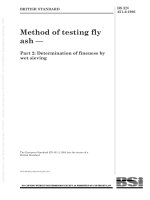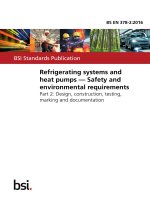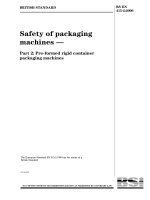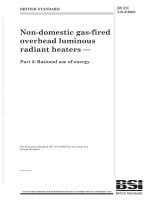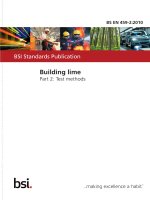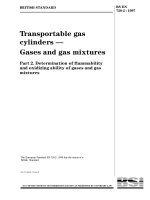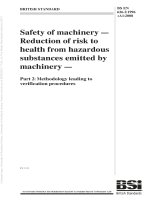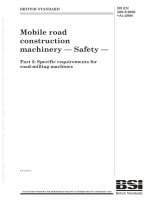Bsi bs en 60730 2 9 2010
Bạn đang xem bản rút gọn của tài liệu. Xem và tải ngay bản đầy đủ của tài liệu tại đây (2.1 MB, 64 trang )
BS EN 60730-2-9:2010
BSI Standards Publication
Automatic electrical controls for
household and similar use
Part 2-9: Particular requirements for temperature
sensing controls
BRITISH STANDARD
BS EN 60730-2-9:2010
National foreword
This British Standard is the UK implementation of EN 60730-2-9:2010. It is
derived from IEC 60730-2-9:2008. It supersedes BS EN 60730-2-9:2002,
which will be withdrawn on 1 November 2013.
The CENELEC common modifications have been implemented at the appropriate places in the text. The start and finish of each common modification
is indicated in the text by tags }~ .
The UK participation in its preparation was entrusted to Technical Committee
CPL/72, Electrical control devices for household equipment and appliances.
A list of organizations represented on this committee can be obtained on
request to its secretary.
This publication does not purport to include all the necessary provisions of a
contract. Users are responsible for its correct application.
© BSI 2011
ISBN 978 0 580 53931 2
ICS 97.120
Compliance with a British Standard cannot confer immunity from
legal obligations.
This British Standard was published under the authority of the Standards
Policy and Strategy Committee on 28 February 2011.
Amendments/ corrigenda issued since publication
Date
Text affected
EUROPEAN STANDARD
EN 60730-2-9
NORME EUROPÉENNE
EUROPÄISCHE NORM
ICS 97.120
November 2010
Supersedes EN 60730-2-9:2002 + A1:2003 + A2:2005 + A11:2003 + A12:2004
English version
Automatic electrical controls for household and similar use Part 2-9: Particular requirements for temperature sensing controls
(IEC 60730-2-9:2008, modified)
Dispositifs de commande électrique
automatiques à usage domestique et
analogue Partie 2-9: Règles particulières pour les
dispositifs de commande thermosensibles
(CEI 60730-2-9:2008, modifiée)
Automatische elektrische Regel- und
Steuergeräte für den Hausgebrauch und
ähnliche Anwendungen Teil 2-9: Besondere Anforderungen an
temperaturabhängige Regel- und
Steuergeräte
(IEC 60730-2-9:2008, modifiziert)
This European Standard was approved by CENELEC on 2010-11-01. CENELEC members are bound to comply
with the CEN/CENELEC Internal Regulations which stipulate the conditions for giving this European Standard
the status of a national standard without any alteration.
Up-to-date lists and bibliographical references concerning such national standards may be obtained on
application to the Central Secretariat or to any CENELEC member.
This European Standard exists in three official versions (English, French, German). A version in any other
language made by translation under the responsibility of a CENELEC member into its own language and notified
to the Central Secretariat has the same status as the official versions.
CENELEC members are the national electrotechnical committees of Austria, Belgium, Bulgaria, Croatia, Cyprus,
the Czech Republic, Denmark, Estonia, Finland, France, Germany, Greece, Hungary, Iceland, Ireland, Italy,
Latvia, Lithuania, Luxembourg, Malta, the Netherlands, Norway, Poland, Portugal, Romania, Slovakia, Slovenia,
Spain, Sweden, Switzerland and the United Kingdom.
CENELEC
European Committee for Electrotechnical Standardization
Comité Européen de Normalisation Electrotechnique
Europäisches Komitee für Elektrotechnische Normung
Management Centre: Avenue Marnix 17, B - 1000 Brussels
© 2010 CENELEC -
All rights of exploitation in any form and by any means reserved worldwide for CENELEC members.
Ref. No. EN 60730-2-9:2010 E
BS EN 60730-2-9:2010
EN 60730-2-9:2010 (E)
–2–
Foreword
The text of the International Standard IEC 60730-2-9:2008, prepared by IEC TC 72, Automatic controls
for household use, together with the common modifications prepared by the Technical Committee
CENELEC TC 72, Automatic controls for household use, was submitted to the CENELEC Unique
Acceptance Procedure.
A draft amendment was prepared by the Technical Committee CENELEC TC 72, Automatic controls
for household use. It was submitted to the Unique Acceptance Procedure.
The combined texts were approved by CENELEC as EN 60730-2-9 on 2010-11-01.
This document supersedes EN 60730-2-9:2002 + A1:2003 + A2:2005 + A11:2003 + A12:2004.
Attention is drawn to the possibility that some of the elements of this document may be the subject of
patent rights. CEN and CENELEC shall not be held responsible for identifying any or all such patent
rights.
The following dates were fixed:
–
–
latest date by which the EN has to be implemented
at national level by publication of an identical
national standard or by endorsement
(dop)
2011-11-01
latest date by which the national standards conflicting
with the EN have to be withdrawn
(dow)
2013-11-01
This Part 2-9 is to be used in conjunction with EN 60730-1:2000, Automatic electrical controls for
household and similar use – Part 1: General requirements, and any subsequent amendments.
This European Standard has been prepared under a mandate given to CENELEC by the European
Commission and the European Free Trade Association and covers essential requirements of
EC Directive 2004/108/EC. See Annex ZZ.
Annexes ZA and ZZ have been added by CENELEC.
__________
–3–
Endorsement notice
The text of the International Standard IEC 60730-2-9:2008 was approved by CENELEC as a European
Standard with agreed common modifications.
BS EN 60730-2-9:2010
EN 60730-2-9:2010 (E)
–4–
CONTENTS
1
Scope and normative references ....................................................................................... 6
2
Definitions ........................................................................................................................ 7
3
General requirements ...................................................................................................... 9
4
General notes on tests ..................................................................................................... 9
5
Rating.............................................................................................................................. 9
6
Classification ................................................................................................................... 9
7
Information ..................................................................................................................... 1 0
8
Protection against electric shock ..................................................................................... 1 2
9
Provision for protective earthing ...................................................................................... 1 2
10 Terminals and terminations ............................................................................................. 1 2
11 Constructional requirements ........................................................................................... 1 2
12 Moisture and dust resistance .......................................................................................... 15
13 Electric strength and insulation resistance....................................................................... 16
14 Heating........................................................................................................................... 16
15 Manufacturing deviation and drift .................................................................................... 17
16 Environmental stress ...................................................................................................... 18
17 Endurance ...................................................................................................................... 18
18 Mechanical strength........................................................................................................ 23
19 Threaded parts and connections ..................................................................................... 24
20 Creepage distances, clearances and distances through solid insulation ........................... 24
21 Fire hazard testing .......................................................................................................... 24
22 Resistance to corrosion .................................................................................................. 24
23 Electromagnetic compatibility (EMC) requirements – emission ........................................ 25
24 Components ................................................................................................................... 25
25 Normal operation ............................................................................................................ 25
26 Electromagnetic compatibility (EMC) requirements – immunity ........................................ 25
27 Abnormal operation......................................................................................................... 26
28 Guidance on the use of electronic disconnection ............................................................. 26
Annexes................................................................................................................................ 27
Annex H (normative) Requirements for electronic controls .................................................... 27
Annex J (normative) Requirements for controls using thermistors ......................................... 32
Annex AA (informative) Maximum manufacturing deviation and drift...................................... 33
Annex BB (informative) Time factor...................................................................................... 34
Annex CC (informative) Number of cycles ............................................................................ 37
Annex DD (normative) Controls for use in agricultural confinement buildings ........................ 38
Annex EE (informative) Guide to the application of temperature sensing controls within
the scope of IEC 60730-2-9 ................................................................................................... 42
Annex ZA (normative) Normative references to international publications with their
corresponding European publications ........................................................................................ 59
Annex ZZ (informative) Coverage of Essential Requirements of EC Directives ........................... 60
Figure 11.4.13.102 – Impact tool ........................................................................................... 13
Figure 17.101.3 – Aluminium cylinder for temperature change method ................................... 22
–5–
Figure BB.1 – Determination of time factor in the case of a sudden temperature change ........ 35
Figure BB.2 – Determination of time factor in the case of a linear rise of test-bath
temperature .......................................................................................................................... 36
Figure EE.1 – Thermostat ..................................................................................................... 51
Figure EE.2 – Self-resetting temperature limiter..................................................................... 52
Figure EE.3 – Non-self-resetting temperature limiter.............................................................. 52
Figure EE.4 – Self-resetting thermal cut-out .......................................................................... 54
Figure EE.5 – Manual reset thermal cut-out ........................................................................... 54
Figure EE.6 – Single operation device ................................................................................... 56
Figure EE.7 – Three-stage control system ............................................................................. 57
Table H.26.2.101 – Compliance criteria ................................................................................. 29
Table BB.1 – Method to determine and verify time factor values (see 11.101) ........................ 36
Table EE.1 – Typical examples of the classification of temperature sensing controls in
accordance with IEC 60730-2-9 ............................................................................................. 5 8
BS EN 60730-2-9:2010
EN 60730-2-9:2010 (E)
–6–
AUTOMATIC ELECTRICAL CONTROLS
FOR HOUSEHOLD AND SIMILAR USE –
Part 2-9: Particular requirements
for temperature sensing controls
1
Scope and normative references
This clause of Part 1 is applicable except as follows:
1.1
Replacement:
This part of IEC 60730 applies to automatic electrical temperature sensing controls for use in,
on or in association with equipment for household and similar use, including electrical controls
for heating, air-conditioning and similar applications. The equipment may use electricity, gas,
oil, solid fuel, solar thermal energy, etc., or a combination thereof.
1.1.1
Replace the explanatory matter with the following new explanatory matter:
Examples of such controls include boiler thermostats, fan controls, temperature limiters and thermal cut-outs.
Throughout this standard, the word "equipment" includes "appliance" and "control system".
1.1.2
Replacement:
This standard also applies to the electrical safety of temperature sensing controls with nonelectrical outputs such as refrigerant flow and gas controls.
1.1.3
Not applicable.
Additional subclause:
1.1.101
1.5
This standard applies to single operation devices as defined in this standard.
Normative references
Addition:
}EN 60216-1, Electrical insulating materials – Properties of thermal endurance – Part 1: Ageing
procedures and evaluation of test results (IEC 60216-1) ~
IEC 60335 (all parts), Household and similar electrical appliances – Safety
IEC 60691:2002, Thermal links – Requirements and application guide
Amendment 1 (2006)
IEC 60730-2-4, Automatic electrical controls for household and similar use – Part 2-4:
Particular requirements for thermal motor protectors for motor-compressors of hermetic and
semi-hermetic type
–7–
2
Definitions
This clause of Part 1 is applicable except as follows:
2.2
Definitions of types of control according to purpose
2.2.19
operating control
Add, to the definition, the following explanatory paragraph:
In general, a thermostat is an operating control.
2.2.20
protective control
Add, to the definition, the following explanatory paragraph:
In general, a thermal cut-out is a protective control.
Additional definitions:
2.2.101
single operation device
SOD
control having a temperature sensing element which is intended to operate only once and then
requires complete replacement
2.2.101.1
bimetallic single operation device
single operation device having a bimetallic temperature sensing element
NOTE 1
A bimetallic single operation device does not reset above a declared temperature (see 11.4.103).
NOTE 2
Requirements for thermal links (which are not allowed to reset) are contained in IEC 60691.
}2.2.101.2
non-bimetallic single operation device
single operation device having a temperature sensing element which is part of a combination action
control, the operation of which cannot be separated from other functions of the control and having a
non-bimetallic thermal element that operates only once and then requires complete or partial
replacement
NOTE 1 When such parts can be tested separately, they are considered to be thermal links within the scope of EN 60691.
NOTE 2 The ageing period and thermal response of the device is dependent on the intended use of the device. As a result,
the nature of the testing applicable to the device should be representative of the application conditions for which the protective
control is intended (see 7.2).
NOTE 3 Non-bimetallic single operation devices provide the equivalent of micro-disconnection.~
2.2.101.2.1
rated functioning temperature
Tf
temperature of the sensing element of a non-bimetallic SOD which causes it to change the
state of conductivity of the control when measured under specified conditions as declared by
the manufacturer
}definitions deleted ~
BS EN 60730-2-9:2010
EN 60730-2-9:2010 (E)
–8–
2.2.102
room thermostat
independently mounted or incorporated thermostat intended to control the temperature of
habitable space
2.2.103
fan control
automatic temperature sensing control intended to control the operation of a fan or blower
2.2.104
boiler thermostat
thermostat intended to control boiler/liquid temperature
2.2.105
modulating thermostat
thermostat which controls the temperature between two limits by continuously controlling the
input to the load
2.2.106
voltage maintained thermal cut-out
thermal cut-out which is maintained in its operated condition by the voltage which appears
across it in that condition
2.2.107
agricultural thermostat
a thermostat intended for use in agricultural confinement buildings
2.3
Definitions relating to the function of controls
2.3.14
Additional definition:
2.3.14.101
time factor
transient response of temperature sensing controls by defined change of the activating quantity
2.5
Definitions of types of control according to construction
Additional definitions:
2.5.101
push-and-turn actuation
two-step actuation accomplished by first pushing, then rotating the actuating member of the
control
2.5.102
pull-and-turn actuation
two-step actuation accomplished by first pulling, then rotating the actuating member of the
control
–9–
3
General requirements
This clause of Part 1 is applicable.
4
General notes on tests
4.1
Conditions of test
This clause of Part 1 is applicable except as follows:
4.1.7
Not applicable.
Additional subclauses:
4.1.101 For the purposes of the tests of this standard and unless otherwise indicated,
ambient temperature excursions beyond T max during abnormal operation as a precursor to
the operation of a manual reset thermal cut-out or a bimetallic SOD are ignored.
}Note deleted~
4.1.102 For manual reset thermal cut-outs and bimetallic SODs which have an operating
value above T max, the temperature at the sensing element is raised, as necessary, to achieve
any cycling required during the tests.
4.2
Samples required
4.2.1
Addition:
Six samples of bimetallic SODs are used for the test of Clause 15 } and a further six for the test
of Clause 17.~
Additional samples are required for the tests of Clause 17.
5
Rating
This clause of Part 1 is applicable.
6
Classification
This clause of Part 1 is applicable except as follows:
6.4
6.4.3
According to features of automatic action
Additional subclauses:
6.4.3.101 – for sensing actions, no increase in the operating value as a result of any leakage
from the sensing element, or from parts connecting the sensing element to the switch head
(Type 2.N);
6.4.3.102 – an action which operates after a declared thermal cycling test as specified
in 17.101 (Type 2.P);
In general, thermal cut-outs for specific applications, such as pressurized water heating systems, may be classified
as having Type 2.P action.
BS EN 60730-2-9:2010
EN 60730-2-9:2010 (E)
– 10 –
6.4.3.103 – an action which is initiated only after a push-and-turn or pull-and-turn actuation and
in which only rotation is required to return the actuating member to the off or rest position
(Type 1.X or 2.X);
6.4.3.104 – an action which is initiated only after a push-and-turn or pull-and-turn actuation
(Type 1.Z or 2.Z);
6.4.3.105 – an action which cannot be reset under electrically loaded conditions } and at
temperatures above -20 °C or at a lower temperature if so declared~ (Type 1.AK or 2.AK);
6.4.3.106 – an action which operates after declared agricultural environmental exposures (Type
1.AM or 2.AM).
6.7
According to ambient temperature limits of the switch head
Additional subclauses:
6.7.101
Controls for use in or on cooking appliances.
6.7.102
Controls for use in or on ovens of the self-cleaning type.
6.7.103
Controls for use in or on food-handling appliances.
}6.7.104 Non-bimetallic SOD for incorporation into appliances for heating or employing liquids or
steam.
NOTE
Not suitable for use in instantaneous water heaters.~
6.8.3
Modification:
Replace the first paragraph by:
For an in-line cord control, a free standing control, an independently mounted control or a control integrated or incorporated in an assembly utilizing a non-electrical energy source:
6.15
According to construction
Additional subclause:
6.15.101 – controls having parts containing liquid metal.
7
Information
This clause of Part 1 is applicable except as follows:
7.2
Methods of providing information
– 11 –
Table 7.2
Addition:
Clause or
subclause
Information
101
Maximum sensing element temperature (other than relevant to
Item 105) 101)
102
Time factor with or without sheath ref.
103
SOD reset temperature (either –35 °C or 0 °C) } (17.15.2.2)~
104
Number of cycles for bimetallic single-operation devices with 0 °C reset
105
Maximum sensing element temperature for the test of 17.16.107 (T e )
106
Controls having parts containing liquid metal
107
Tensile yield strength
102)
103 )
Method
6.7
6.15
14.101
X
2.3.14.101
11.101
BB.1.2
2.2.101
11.4.103
}17.15.2.2~
17.15.1.3.1
X
X
X
6.7.102
17.16.107
D
6.15.101
11.1.101
18.102
D
11.1.101
X
108
Minimum current for the purpose of the test of 23.101
23.101
D
109
T max.1 is the maximum ambient temperature in which the control may remain
continuously in the operated condition so that Table 14.1 temperatures are
not exceeded 105)
14.4.3.1
D
110
Time period, t 1 , is the maximum time during which the ambient temperature
can be higher than T max.1 after the control has operated 105)
14.4.3.1
D
111
Temperature limit above which automatic reset of a manual reset thermal
cut-out or a voltage maintained thermal cut-out shall not occur
(not higher than –20 °C)
2.2.105
11.4.106
17.16.104.1
17.16.108
X
112
For Type 2.P controls, the method of test
17.101
X
113
The click rate N or switching operations per minute for the purposes of testing
to CISPR 14-1
23
X
114
Rated functioning temperature (T f )
2.2.101.2.1
17.15.2
C
17.15.2.2.1
17.15.2.2.2
D
115 }Ageing temperature for non-bimetallic SOD
106)
116
Rate of rise of temperature for testing non-bimetallic SOD
117
Agricultural thermostat
107)
17.15.2.2.1
17.15.2.2.2~
2.2.107
D
D
6.4.3.106
11.4.107
11.6.3.101
Annex DD
601 } The minimum voltage at which a voltage maintained thermal cut -out will
not reset (this shall not be higher than 0,85 times the minimum rated voltage).
11.4.106~
NOTES
Additional notes
101)
102)
This declaration applies only to temperature sensing controls containing liquid metal. For temperature
sensing controls used in or on self-cleaning ovens, this declaration is the temperature for the cooking
operation.
}text deleted~ Controls using liquid metal are allowed only with a special marking on the control.
Documentation (D) shall contain a clear warning of the actual danger that may occur. The following symbol
shall be used for marking the control: !
103)
When no minimum is declared, the test value is 15 mA.
105)
Consideration should be given to the provision of information by the equipment manufacturer relating to the
minimum time that the appliance has to be disconnected from the supply to allow a voltage maintained
thermal cut-out to reset.
}106) Determined by the control manufacturer based on the opening temperature of the thermal-cut out.
107)
Determined by the control manufacturer referring to the actual maximum rate of rise probable in the projected
end-use equipment.~
BS EN 60730-2-9:2010
EN 60730-2-9:2010 (E)
8
– 12 –
Protection against electric shock
This clause of Part 1 is applicable.
9
Provision for protective earthing
This clause of Part 1 is applicable.
10 Terminals and terminations
This clause of Part 1 is applicable.
11 Constructional requirements
This clause of Part 1 is applicable except as follows:
11.1
Materials
Additional subclause:
11.1.101
Parts containing liquid metal
For controls declared under Item 106 of Table 7.2, parts that contain mercury (Hg), and parts
of any control that contain sodium (Na), potassium (K), or both, shall be constructed of metal
that has a tensile yield strength at least four times the circumferential (hoop) or other stress on
the parts at a temperature 1,2 times the maximum temperature of the sensing element (T e ).
Compliance is checked by inspection of the manufacturer's declaration and by the test
of 18.102.
}Insulating material used in non-bimetallic SODs as defined in this standard shall comply with the
requirements of EN 60216-1:2001 and be suitable for the application.~
11.3
Actuation and operation
11.3.9
Pull-cord actuated control
Addition:
The second explanatory paragraph is not applicable to controls classified as Type 1.X or 2.X or Type 1.Z or 2.Z.
11.4
Actions
11.4.3
Type 2 action
Additional subclauses:
11.4.3.101
Capacitors shall not be connected across the contacts of a thermal cut-out.
}Note deleted~
11.4.3.102
permitted.
Constructions requiring a soldering operation to reset thermal cut-outs are not
11.4.13
Replacement:
11.4.13
Type 2.K action
Additional subclauses:
– 13 –
11.4.13.101 A Type 2.K action shall be so designed that in the event of a break in the sensing
element, or in any other part between the sensing element and the switch head, the declared
disconnection or interruption is provided before the sum of the declared operating value and
drift is exceeded.
Compliance is checked by breaking the sensing element. The breaking may be achieved by
partly pre-cutting or filing through.
The temperature sensing control is heated to within 10 K of the operating temperature and the
temperature then increased at a rate not to exceed 1 K/min. The contacts shall open before the
sum of the declared operating value plus drift is exceeded.
11.4.13.102
Type 2.K action may also be achieved by compliance with a), b) or c).
a) Two sensing elements operating independently from each other and actuating one switched
head.
b) Bimetallic sensing elements with
1) exposed elements attached with at least double spot welding of the bimetal at both of
its ends, or
2) elements so located or installed in a control of such construction that the bimetal is not
likely to be physically damaged during installation and use.
c) If the loss of the fluid fill causes the contacts of the control to remain closed or leakage
causes upward shift beyond the declared maximum operating temperature, the bulb and
capillary of a temperature sensing control which is actuated by a change in the pressure of
a fluid confined in the bulb and capillary shall conform to the following.
There shall be no damage to the bulb or capillary to the extent which will permit escape of
any of the fill when an impact tool, as illustrated in Figure 11.4.13.102, is dropped once
from a height of 0,60 m so that the tapered end of the tool strikes the bulb or capillary in a
perpendicular position. For this test, the capillary or the bulb shall be on a concrete surface.
If the capillary is provided with a separate shroud or sleeve, it is to be left in place during the test described
above.
(25,4 mm)
60
°
(25,4 mm)
R = 3,2 mm
L
IEC 564/2000
Material: Steel, CRS, Break all corners
L to be sized to obtain total mass of 0,454 kg
Figure 11.4.13.102 – Impact tool
BS EN 60730-2-9:2010
EN 60730-2-9:2010 (E)
– 14 –
Additional subclauses:
11.4.101
Type 2.N action
A Type 2.N action shall be so designed that in the event of a leak in the sensing element, or in
any other part between the sensing element and the switch head, the declared disconnection
or interruption is provided before the sum of the declared operating value and drift is exceeded.
Compliance is checked by the following test:
The operating value of a Type 2.N control is measured under the conditions of Clause 15
of Part 1. If the control has means for setting, it is set to the highest value.
After this measurement, a hole is artificially produced in the sensing element and the
measurement of the operating value is repeated.
No positive drift is allowed above the declared value.
}Note deleted~
11.4.102
Type 2.P action
A Type 2.P action shall be so designed that it operates in its intended manner after a thermal
cycling test.
Compliance is checked by the test of 17.101.
11.4.103
Bimetallic single-operation device
A bimetallic single-operation device shall be so designed that it does not reset above the reset
value declared in Table 7.2, Item 103.
Compliance is checked by the test of 17.15.
11.4.104
Type 1.X or 2.X
A Type 1.X or 2.X action shall be so designed that a turn action can only be accomplished after
the completion of a push action or a pull action. Only rotation shall be required to return the
actuating member of the control to the off or rest position.
Compliance is checked by the tests of 18.101.
11.4.105
Type 1.Z or 2.Z
A Type 1.Z or 2.Z action shall be so designed that a turn action can only be accomplished after
the completion of a push action or a pull action.
Compliance is checked by the tests of 18.101.
}11.4.106 Voltage maintained thermal cut-out (Type 1.AK or Type 2.AK)
A voltage maintained thermal cut-out shall be so designed that it does not automatically reset at any
temperature higher than -20 °C or any lower temperature declared in Table 7.2, Requirement 111.
Compliance is checked by the following test which is carried out as part of 17.14:
The voltage maintained thermal cut-out shall be maintained, in an operated condition, at - 20 °C or at
any lower temperature declared by the manufacturer in Table 7.2, Requirement 111.
The voltage maintained thermal cut-out is connected to the voltage value declared in Table 7.2,
Requirement 601, in series with a resistance of a value which will limit the current through the control to
not more than the maximum rated current together with a suitable means to detect resetting of the
thermal cut-out.
The test will continue for 1 h. The device shall not reset during this period. ~
– 15 –
11.4.107
Type 1.AM or 2.AM
A Type 1.AM or 2.AM action shall be so designed that it operates in its intended manner after
the declared agricultural environmental exposures.
Compliance is checked by the tests of Annex DD.
11.6
Mounting of controls
11.6.3
Mounting of independently mounted controls
Additional subclause:
11.6.3.101 For agricultural thermostats declared in Table 7.2, Item 117, the mounting method
shall be such that the integrity of the protection by the enclosure is not compromised.
Additional subclause:
11.101
Time factor
If a time factor is declared, this shall be checked by one of the applicable determining methods
as indicated in Annex BB. The determined value shall not exceed the rated values.
See Table BB.1.
}Note deleted~
12 Moisture and dust resistance
This clause of Part 1 is applicable except as follows:
Additional subclauses:
12.101
Refrigeration controls
Controls which have the switch head and sensing element mounted in the evaporator of
refrigeration or similar equipment, producing conditions of overtemperature and of freezing and
melting, shall maintain insulation integrity.
12.101.1
Compliance is checked by the following tests.
12.101.2 Controls which use a potting compound are given a softening test. Two samples are
heated in a heating chamber at 15 K above the maximum declared operating temperature for
16 h with the potting surface in the most unfavourable position. The potting material shall not
unduly soften or distort, crack or deteriorate.
12.101.3 The two samples used for the softening tests and one untested sample (three total)
are placed in water maintained at (90 ± 5) °C for 2 h. The three samples are then immediately
transferred to water at a temperature of below 5 °C and then frozen in a small, flexible
container at –35 °C for 2 h. Ten heating-freezing cycles are required.
}Note deleted~
12.101.4 Two consecutive heating-freezing cycles are performed in one working day, and
then 10 cycles are completed in five consecutive days, with the samples left in water at room
temperature for four overnight periods.
BS EN 60730-2-9:2010
EN 60730-2-9:2010 (E)
– 16 –
12.101.5 After the last freezing test, the samples are thawed to approximately room
temperature in water and the insulation resistance is measured from current-carrying parts to
grounded parts and to the surface of potting and/or insulating material; the direct current
voltmeter method is used. Insulation resistance shall be at least 50 000 Ω .
12.101.6 While the samples are still moist, a voltage equal to (2 × V R ) + 1 000 V is applied at
rated frequency for 1 min between current-carrying parts and grounded parts and the surface
of the potting and/or insulating material. No flashover or breakdown of insulation shall occur
during the test.
13 Electric strength and insulation resistance
This clause of Part 1 is applicable.
}text deleted ~
14 Heating
This clause of Part 1 is applicable except as follows:
14.4.3.1 The second paragraph is under consideration.
Addition:
For a voltage maintained thermal cut-out, the heating test of 14.4.3.1 is completed, after which
the temperature of the sensing element is raised until the contacts open. At this time, the
ambient temperature surrounding the sensing element is reduced to T max.1 in time period t 1 , at
a uniform rate. The test of 14.5.1 is then completed.
Table 14.1
Note 13) is under consideration.
Additional subclauses:
14.101
The following is applicable to controls classified under 6.7.101 to 6.7.103 inclusive.
14.101.1 As a means of complying with Note 12) of Table 14.1, if the temperature of
insulating parts exceeds that permitted in Table 14.1, then the test of 17.16.101 may be
conducted after the conditioning of 14.102 and 14.102.1.
14.102 A previously untested sample of the control is conditioned for 1 000 h in an oven
maintained at a temperature between 1,02 T 1 + 20 K and 1,05 times that temperature where T 1
is the maximum measured temperature on the insulating part during the test of Clause 14. The
control shall not be energized during this test.
14.102.1 If the elevated temperature is localized, such as at or near a terminal, the 1 000 h
conditioning is conducted with the control between T max and T max + 5 % for normal conditions,
but with the contacts closed and non-cycling. If necessary, the contacts may be forced closed
to provide the most arduous temperature conditions. A bimetal heater across the mains
is energized at 1,1 times rated voltage. A series bimetal heater shall conduct at 1,1 times rated
current.
– 17 –
15 Manufacturing deviation and drift
This clause of Part 1 is applicable except as follows:
15.1
Addition:
The values of manufacturing deviation and drift shall be according to Annex AA unless
otherwise declared by the manufacturer.
The explanatory matter is not applicable.
15.4
Addition:
Alternatively, the declared manufacturing deviation and drift may be expressed separately as a
tolerance value to the declared operating value.
15.5.3
Additional subclauses:
15.5.3.101 Controls intended for setting by the user shall be set at the maximum operating
temperature unless otherwise declared by the manufacturer.
15.5.3.102 Controls utilizing a bimetallic or similar sensing mechanism or that portion of a
control intended to be exposed to a controlled ambient shall be placed in a circulating air oven
to determine the operating value.
15.5.3.103 For bimetallic and similar type controls, the temperature shall be determined by
mounting a 0,25 mm thermocouple wire to the sensing portion of an identical control not
electrically connected and mounted adjacent to the control under test in a circulating air oven.
15.5.3.104 For fluid expansion type controls, a maximum 0,25 mm thermocouple shall be
attached to the sensing portion, using a suitable adhesive.
15.5.3.105 For fluid expansion or contraction type controls, the complete control or, if so
intended in use, the bulb portion, or that length of a sensing portion of a control declared by the
manufacturer as being a minimum sensing dimension shall be placed in either a circulating air
oven or a liquid bath.
15.5.3.106 The temperature of the oven or bath may be rapidly increased to 10 K below
or decreased to 10 K above the expected operating temperature of the control until conditions
of equilibrium have been achieved. The rate of temperature change shall then be reduced to
a maximum of 0,5 K/min or to the declared rate of change, whichever is the lowest.
15.5.3.107 The operation of the control shall be sensed by a suitable device with a sensing
current not exceeding 0,05 A.
The circuit voltage may be any convenient value that will give reliable indication of the function
being monitored.
15.5.3.108
The operating value of the control shall be recorded.
15.5.3.109 }For SODs, after the contacts have operated, satisfactory disconnection is determined
by subjecting each SOD device to the voltage specified in Table 13.2, with no prior humidity treatment.~
15.5.4 and 15.5.5
Not applicable.
BS EN 60730-2-9:2010
EN 60730-2-9:2010 (E)
15.5.6
– 18 –
Addition:
Alternatively, the manufacturing deviation shall be according to Annex AA.
16 Environmental stress
This clause of Part 1 is applicable except as follows:
Addition:
}All controls except bimetallic SODs shall be environmentally conditioned as per Clause 16 of
EN 60730-1.~
17 Endurance
This clause of Part 1 is applicable except as follows:
17.3.1 Addition:
–
for controls in which the whole control is declared as the sensing element and for which the
minimum operating temperature declared in Table 7.2, Item 48, is less than 0 °C, the test of
Subclause 17.8 is carried out on a further set of three samples at the minimum declared
operating temperature with a tolerance of +5 K, –0 K, the number of cycles being 5 % of the
number declared in Table 7.2, Item 27.
17.8.4
Additional subclause:
17.8.4.101 The number of automatic and manual cycles for independently mounted and in-line
cord controls shall be as indicated in Clause CC.1, unless a higher number is declared by the
manufacturer.
}Note deleted~
17.15
This subclause of Part 1 is replaced as follows:
17.15
Single operation devices
17.15.1
Bimetallic single operation devices
Bimetallic single operation devices shall be subjected to the following tests:
17.15.1.1 After the appropriate tests of Clause 15, the same six samples shall be maintained
at –35 °C or 0 °C as declared in Table 7.2, Item 103, for 7 h. The devices shall not reset during
this period, which is determined by the test of 15.5.3.109.
17.15.1.2 Six untested bimetallic single operation devices are conditioned for 720 h at
a temperature which is the lower of either:
−
90 % of the declared operating value ±1 K,
−
or (7 ± 1) K below the declared operating value.
17.15.1.2.1 During this conditioning, the bimetallic single operation device shall not operate.
Operation of the bimetallic single operation device shall be detected as indicated in 15.5.3.107.
17.15.1.2.2 The appropriate tests of Clause 15 shall be repeated on the six samples
subjected to the conditioning of 17.15.1.2 and the temperature measured shall be within the
declared deviation limits.
– 19 –
17.15.1.3 For bimetallic single operation devices with a declared reset temperature of
–35 °C, six untested samples shall be subjected to an over-voltage }test for one cycle
under the electrical conditions of Table 17.2-1.~
The test of 15.5.3.109 shall be repeated.
17.15.1.3.1 For bimetallic single operation devices with a declared reset temperature of 0 °C,
one sample shall be subjected to an over-voltage }test of 50 cycles under the electrical
conditions of Table 17.2-1.~
The sample is then subjected to the number of cycles declared in Table 7.2, Item 104, at rated
current and voltage.
NOTE The purpose of the tests of 17.15.1.3.1 is to evaluate the device under unintended operation caused by
exposure to temperatures below 0 °C. In order to achieve cycling, it is suggested that the test be conducted in
a test chamber which permits decrease of the ambient temperature to the declared reset value and increase of
the ambient temperature to the normal operating value.
After the test of 17.15.1.3.1, the appropriate tests of Clause 15 shall be repeated and the
temperature measured shall be within the declared deviation limits.
}17.15.2
Non-bimetallic single operation devices
Non-bimetallic Single Operation Devices are subject to the following tests:
For a non-bimetallic SOD, automatic temperature sensing functions except those for the non-bimetallic
part of the control, such as thermostat, temperature limiter and/or the thermal-cut-out, shall comply
with 17.16.101, 17.16.103 and 17.16.104 respectively.
These tests are conducted on separate samples.
The apparatus used for the tests of 17.15.2.1 and 17.15.2.2 shall be constructed so that heat can be
applied to the thermal sensing element of the single operation device whilst taking care that other parts
of the control are protected from exposure to temperatures in excess of their intended use.
17.15.2.1
Six untested samples are then to be mounted in a suitable apparatus and the thermal
sensing elements are conditioned for an ageing period equal to either 750 h or the result of the
specified number of cycles declared by the end product application divided by 4 (calculation value is
the number of hours), whichever is greater. The ageing temperature is declared in Table 7.2, Item 115,
tolerance of 0 K -5 K. No operation of the single operation devices shall occur during this ageing
period. Operation of the devices shall be detected as indicated in 15.5.3.107.
17.15.2.2 At the end of the ageing period, the samples are removed from the apparatus.
The appropriate tests of Clause 15 shall be repeated on six untested samples and the six samples
subjected to the conditioning of 17.15.2.1 and the temperatures measured shall be within the declared
deviation limits, with the electrical conditions of the test VRmax and IRmax.
For non-bimetallic SOD's where any sensing element has a declared reset temperature, the SOD's
shall be held at the temperature declared in Table 7.2, the test shall continue for 7 h. The device shall
not reset during this period as determined as indicated in 15.5.3.109.
All samples shall then be subjected to the test of Clause 13, carried out at the temperature limits
declared in Table 7.2, Requirement 36.
NOTE: The apparatus used for the tests of 17.15.2.1 and 17.15.2.2 shall be constructed so that heat can be applied to the
thermal sensing element of the SOD whilst taking care that other parts of the control are protected from exposure to
temperatures in excess of their intended use. ~
17.16
Test for particular purpose controls
Additional subclauses:
17.16.101
Thermostats
–
17.1 to 17.5 inclusive are applicable.
–
17.6 is applicable to actions classified as Type 1.M or Type 2.M, the value of "X" being
(5 ± 1) K or ±5 % of the original activating quantity, whichever is greater.
BS EN 60730-2-9:2010
EN 60730-2-9:2010 (E)
– 20 –
–
17.7 is applicable.
–
17.8 is applicable.
–
17.9 is applicable, but only to slow-make, slow-break automatic actions.
–
17.9.3.1 is not applicable.
–
17.10 to 17.13 inclusive, are applicable, but only to those thermostats which have a manual
action (including an actuating means providing setting by the user).
–
17.14 is applicable.
–
17.15 is not applicable.
}text deleted~
17.16.103
Temperature limiters
–
17.1 to 17.5 inclusive are applicable.
–
17.6 is applicable to actions classified as Type 1.M or Type 2.M, the value of "X" being
(5 ± 1) K, or ±5 % of the original activating quantity, whichever is greater.
–
17.7 and 17.8 are applicable, except that, where necessary, the reset operation, if required, is obtained by actuation.
This actuation shall be as specified in 17.4 for accelerated speed, as soon as permitted by the
mechanism, or as declared by the manufacturer in Table 7.2 Item 37.
–
17.9 is applicable, but only to temperature limiters with slow-make, slow-break automatic
actions, the same conditions for manual reset as specified above for 17.7 and 17.8 being
used.
–
17.9.3.1 is not applicable.
–
17.10 to 17.13 inclusive, do not apply to the normal reset manual action, which is tested
during the automatic tests of 17.7 to 17.9 inclusive. If the temperature limiter has other
manual actions which are not tested during the automatic tests, then these subclauses
are applicable.
–
17.14 is applicable.
–
17.15 is not applicable.
17.16.104
Thermal cut-outs
–
17.1 to 17.5 inclusive are applicable.
–
17.6 is applicable to actions classified as Type 1.M or Type 2.M, the value of "X" being
(5 ± 1) K, or ±5 % of the original activating quantity, whichever is greater.
–
17.7 and 17.8 are applicable, except that, where necessary, the reset operation, if required, is obtained by actuation.
This actuation shall be as specified in 17.4 for accelerated speed, as soon as permitted
by the mechanism, or as declared by the manufacturer in Table 7.2, Item 37.
–
17.9 is applicable, but only to thermal cut-outs with slow-make, slow-break automatic
actions, the same conditions for manual reset as specified above for 17.7 and 17.8 being
used.
–
17.9.3.1 is not applicable.
–
17.10 to 17.13 inclusive do not apply to the normal reset manual action, which is tested
during the automatic tests of 17.7 to 17.9 inclusive. If the thermal cut-out has other
manual actions which are not tested during the automatic tests, then these subclauses
are applicable.
–
17.14 is applicable.
–
17.15 is not applicable.
17.16.104.1
For voltage maintained thermal cut-outs, the test of 17.16.108 is applicable.
– 21 –
17.16.105
17.16.106
}Void ~
Evaluation of materials
The following tests are conducted as indicated in 14.101.1.
The control is subjected to the tests of 17.7 for 50 operations and 17.8 for 1 000 operations.
The tests of 17.7 and 17.8 are conducted at an ambient temperature of (20 ± 5) °C.
After these tests, the control shall comply with 17.5.
17.16.107
Over-temperature test of sensing element
For controls declared under Item 105 of Table 7.2, the sensing element portion of a previously
untested sample is exposed to 250 thermal cycles.
The test ambient temperature is varied between 40 °C and T e at the maximum rate of temperature change declared in Table 7.2, Item 37. The extremes of temperature are maintained for
30 min.
After the test, the control shall comply with 17.14.
17.16.108
Voltage maintained thermal cut-out
Six untested voltage maintained thermal cut-outs are conditioned for 7 h at a temperature of
–20 °C (or lower, if declared).
During and at the conclusion of the conditioning, none of the six samples shall have operated.
Operation of the voltage maintained thermal cut-outs shall be detected as indicated in
15.5.3.107.
These requirements apply to a voltage maintained thermal cut-out in the operated condition
with the voltage across it.
Additional subclauses:
17.101
Type 2.P cycling test
Temperature sensing controls of Type 2.P action shall be tested as follows:
17.101.1 Following the appropriate tests of 17.16 and the evaluation of 17.14, the control is
subjected to a thermal cycling test of 50 000 cycles at a temperature maintained between 50 %
and 90 % of the switch-off temperature recorded in 17.14. During this test, the switch head
is maintained at (20 ± 5) °C.
The manufacturer shall declare whether the method of 17.101.2 or 17.101.3 is to be used.
The test shall be carried out in accordance with the manufacturer’s declaration in Item 112 of
Table 7.2.
BS EN 60730-2-9:2010
EN 60730-2-9:2010 (E)
17.101.2
– 22 –
Two-bath method
The two baths are filled with synthetic oil, water or air (two chambers). The first bath is maintained at a temperature equal to 90 % of the switch-off temperature ( °C) recorded in 17.14.
The second bath is maintained at a temperature equal to 50 % of the switch-off temperature
recorded in 17.14.
If a medium different from that used in Annex BB is selected for this test, then an appropriate conversion factor
shall be applied to the time factor indicated in the following paragraph.
The temperature sensing element (see 2.8.1 and Table 7.2, Item 47) is immersed in the first
bath for a period of time equal to at least five times the time factor. The temperature sensing
element is then immersed in the second bath for the same period of time.
The transfer between baths is carried out as quickly as possible but care should be taken to avoid mechanical
stress to the temperature sensing element.
17.101.3
Temperature change method
This method is based on a continuously water-cooled oil-filled bath (synthetic oil).
An aluminum cylinder (see figure 17.101.3) is immersed in this bath. The cylinder contains
the temperature sensing element under test and a temperature sensing element to control
temperature cycling between 50 % and 90 % of the switch-off temperature (°C) recorded
in 17.14.
The aluminium cylinder is wrapped with a resistance wire to heat the temperature sensing
element. To eliminate the difficulties resulting from the difference between the time factor
of the temperature sensing element under test and the temperature sensing element which is
controlling the test temperature range, the temperature sensing element of a second identical
test sample is used.
The two membrane positions of the second sample, calculated at 50 % and 90 % of the switchoff temperature (°C) are measured by a position sensor and used to switch the current through
the resistance wire (heat) on and off.
Unless otherwise declared by the manufacturer in Table 7.2, Item 37, the rate of change of
temperature rise/fall shall be (35 ± 10) K/min.
1
2
IEC 849/08
Key
1
Temperature sensing element
2
Temperature sensing element to control the temperature
cycle between 0,5 and 0,9 times the switch-off temperature
Figure 17.101.3 – Aluminium cylinder for temperature change method
– 23 –
17.101.4 After this test, for controls other than bimetallic SODs, an additional 20 cycles are
carried out by increasing the temperature from (20 ± 5) °C to 1,1 times the switch-off temperature.
During this test, any manual reset mechanism shall not be reset. The other conditions
of 17.101.1 are unchanged.
The purpose of this test is to stress the operating mechanism (for example, membrane, bellows, etc.).
17.101.5 After thoroughly degreasing the switch head, the operating temperature(s) is rechecked under the conditions of Clause 15 and the measured value(s) shall still be within the
declared limits of deviation and drift.
18 Mechanical strength
This clause of Part 1 is applicable except as follows:
Additional subclauses:
18.101
Push-and-turn or pull-and-turn actuation
18.101.1 Controls with actions classified as Type 1.X or 2.X or Type 1.Z or 2.Z shall be
subjected to the tests of 18.101.2 and 18.101.3.
One new sample is used for the tests. After these tests, the control shall comply with the
requirements of 18.1.5.
18.101.2
Controls with actions classified as Type 1.X or 2.X or Type 1.Z or 2.Z shall be subjected to the
following tests.
–
The axial force required to push or pull the actuating member shall be not less than 10 N.
–
An axial push or pull force of 140 N applied to the actuating member shall not affect
compliance with 18.1.5.
–
For a control intended for use with a knob having a grip diameter or length of 50 mm or
less, the means preventing rotation of the shaft prior to the push or pull actuation shall
withstand, without damage, or effect on control function, a torque of 4 Nm.
–
Alternatively, if the means preventing rotation of the shaft is defeated when a torque of at
least 2 Nm is applied, the effect shall be such that either
•
the means is not damaged, but overridden to close the contacts, in which case
subsequent actuation at a torque less than 2 Nm shall require both push-and-turn or
pull-and-turn to operate the contacts, or
•
no operation of the contacts occurs nor can be made to occur.
–
The torque required to reset the control to the initial contact condition, if necessary after
the application of the push or pull, shall not be greater than 0,5 Nm.
–
A torque of 6 Nm is applied to the setting means. Any breakage or damage to the means
preventing rotation of the shaft shall not result in failure to comply with the requirements
of Clauses 8, 13 and 20.
–
For controls intended for use with a knob having a grip diameter or length greater than
50 mm, the values of torque are increased proportionally.
18.101.3 Controls with actions classified as Type 1.X or 2.X or Type 1.Z or 2.Z shall be
actuated for the declared number of manual cycles.

